Examples of sampled features
A good feature
The material appears to be well heated as it is reddened. The deposit is over 2cm thick which suggests that it was well fired as the heat penetrated downwards through the material. The feature does not appear to have been disturbed, despite being half sectioned as there are no signs of it being cracked.
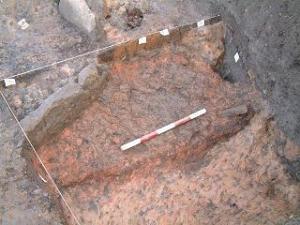
The importance of covering the feature
The importance of covering the feature
It is important to cover a feature once it has been revealed to prevent it from being disturbed, as well as protecting it from the effects of the weather. The feature used in this example was a hearth that was left exposed after it was excavated. It suffered from the action of the rain and from plants growing in the heated material.
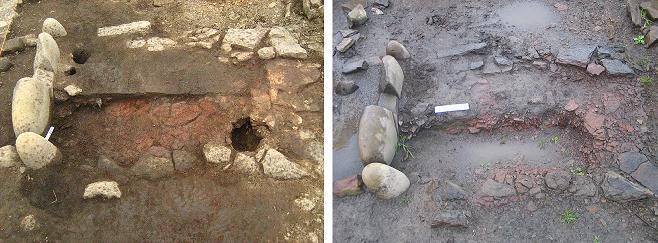
The Cairns, Orkney (Photo copyright S.J. Clelland, University of Bradford)
Magnetic mineralogy
A deposit must contain suitable magnetic minerals in sufficient quantities to be able to record the Earth's magnetic field. It is not possible to determine this in on site, only in the laboratory, and so features that look promising may not be able to be used for archaeomagnetic dating.
The example used here was interpreted as an area of burning as it was reddened and hard fired. The deposit was approximately 3cm thick, suggesting that the feature was well-fired as the heat had penetrated downwards,with no obvious signs of disturbance. The measurement of the samples in the laboratory demonstrated that the magnetic minerals were either unsuitable or in too low concentrations to record the Earth's magnetic field, and so could not be used to produce an archaeomagnetic date.
(Photo copyright S.J. Clelland, University of Bradford)
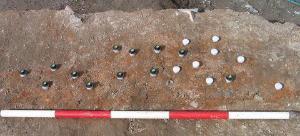
Parc Cybi, Ty Mawr, Holyhead, North Wales
Problems of compaction
The Earth's magnetic field is characterised by three measurable parameters: declination, inclination and intensity. The inclination relates to the field direction above or below the horizontal. If the feature is compacted in any way, this will alter the inclination of the feature so that it will no longer accurately record the direction of the past field.
The example used here represented an area of burning sealed by stone that was well-fired and heat-reddened. The stones sealing the feature had been used as a step to exit the trench before it was realised that they sealed a heated feature. The pressure of people walking over the feature caused it to be compacted, physically distorting the inclination of the feature.
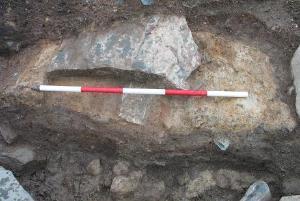
Parc Cybi, Ty Mawr, Holyhead, North Wales (Photo copyright S.J. Clelland, University of Bradford)
A slumped feature
The feature shown here was interpreted as an area of burning contained within upright stones. The colour and the considerable depth of the material associated with the feature indicated that it was well fired. However, the material was not in situ. The stone highlighted with a red dot was thought to have collapsed backwards, causing the fired material within the feature to slump outwards in the direction of the stone.
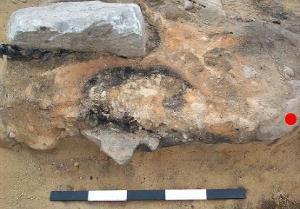
Birnie, Moray (Photo copyright D.P. Greenwood, University of Bradford)
Limited fired clay
A minimum of eight specimens should be collected from a feature to ensure that random disturbances in the magnetisation are averaged, and the resulting measurements of the magnetism are not biased. In this example, only a small areas of heat affected clay (the red material) was preserved in the hearth. The two specimens that sampled this material returned significantly different directions than the remaining specimens.
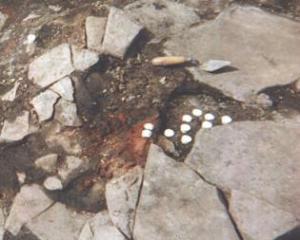
Old Scatness Broch, Shetland (Photo copyright C.M. Batt, University of Bradford)
Magnetic refraction
The shape of a structure as well as certain aspects of its material composition can distort the magnetisation direction recorded by a feature. However, such distortions tend to vary in different parts of the structure and so samples need to be collected from all of the exposed areas to allow the degree of distortion to be investigated. Magnetic shallowing was noted for the samples collected from the Bolsterstone glass house, which was overcome following the application of standard correction using the methodology proposed by Aitken and Hawley (1971) and Clark et al. (1988).
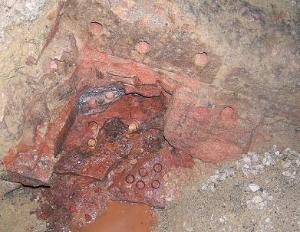
Bolsterstone glass house, Stocksbridge (Photo copyright M.W. Hounslow, University of Lancaster)
